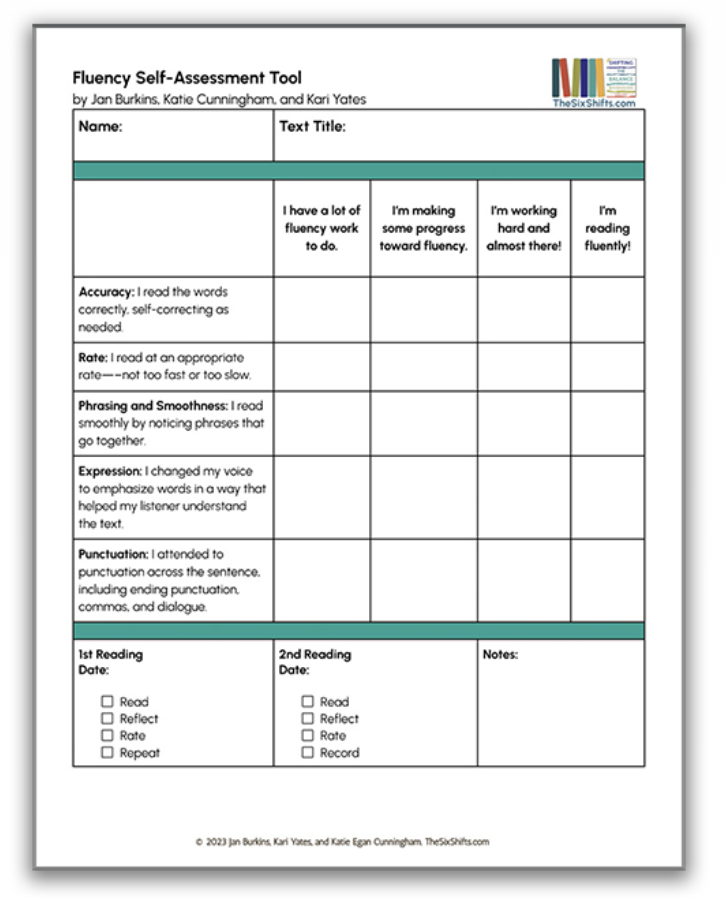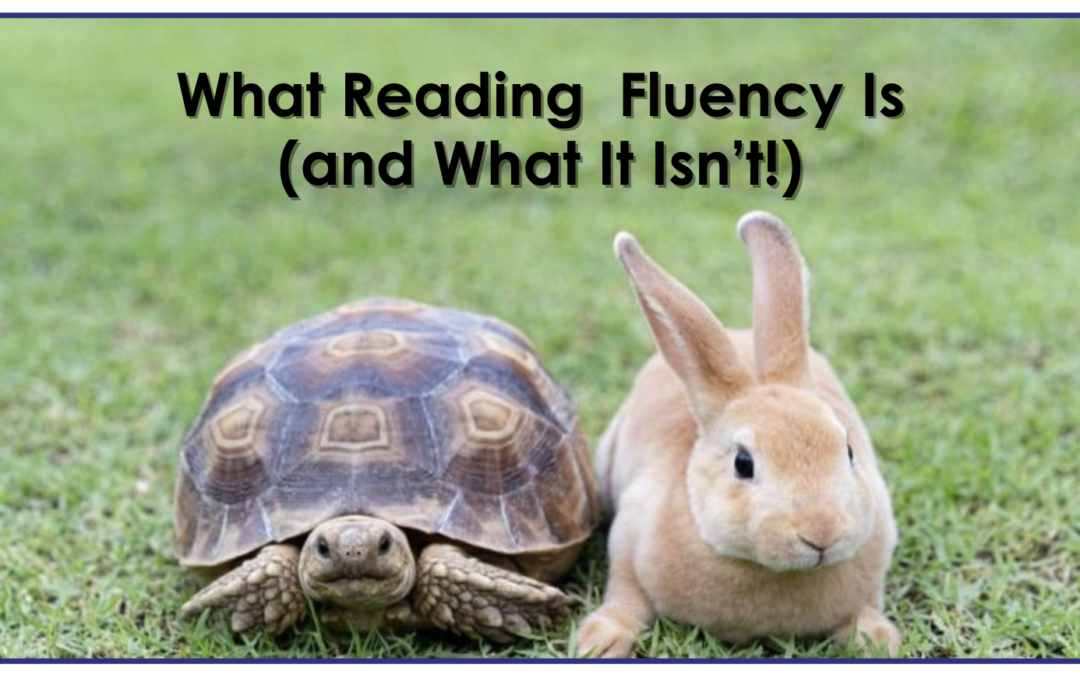Think of a time when someone read aloud to you in a way that captured your imagination. Whether it was a caregiver making a bedtime story magical or a teacher bringing characters to life, these moments stick with us.
What made those experiences unforgettable? Fluency. The ability to read with expression, accuracy, and rhythm draws us in, making the experience meaningful and engaging.
But what exactly is fluency, and why does it matter so much? In this post, we’ll explore what fluency is, why it’s vital for young readers, and how you can help your students develop it with purpose, practice, and playfulness.
What is Reading Fluency?
Fluency is one of those literacy buzzwords we often hear, but not everyone agrees on the same reading fluency definition. Is fluency about speed? Expression? Accuracy? (Spoiler alert: It’s all those things—but it’s more than that, too.)
Fluency is reading text with accuracy, appropriate speed, and expression—all while understanding what you’re reading. In their Active View of Reading (2021), Duke and Cartwright refer to fluency as a “bridging skill” because it relies on both decoding (figuring out the words) and language comprehension (making sense of what those words mean).
And let’s face it: Without fluency, reading can feel like marching through mud—it requires a lot of effort with little payoff.
But let’s clear up a common misconception: fluency is not just about speed.

Yes, reading at a reasonable pace is important, but rushing through text without understanding is like sprinting through a museum without stopping to appreciate the art—it misses the point. Fluency is about finding a rhythm, letting words flow naturally, pausing when it makes sense, and bringing the text to life. Fluent reading should sound like a natural conversation, not a podcast sped up to 2X.
Building Reading Fluency: Why It Matters
Fluency is more than just a skill—it’s the bridge between word reading and comprehension. Here’s why it’s essential for young readers:
• It Builds Confidence
Fluent reading sounds like natural conversation, helping children feel successful and motivated. Without fluency, reading feels slow and awkward, making it harder for students to see themselves as capable readers.
• It Supports Comprehension
When students read fluently, they free up mental energy to focus on understanding—connecting ideas, visualizing, and predicting. Think of it like closing extra tabs on a computer to speed things up; fluency reduces the cognitive load, so meaning takes center stage.
• It Enhances Silent Reading
The voice students practice aloud becomes the voice they “hear” during silent reading. So, oral reading fluency strengthens pacing, phrasing, and comprehension, making silent reading smoother and more effective.
• It Unlocks Lifelong Reading
Fluency opens the door to reading for learning, enjoyment, and curiosity. When fluency develops, students move beyond the hard work of decoding to truly engage with texts. Without it, reading can feel like a frustrating barrier rather than an opportunity.
Repeated Reading: Star of the Fluency Practice Show
When it comes to building fluency, repeated reading is the star of the show. Time and again, research proves that reading the same passage multiple times improves accuracy, speed, and expression. Repeated reading allows students to build familiarity with the text, freeing up their brainpower to focus on flow and meaning.
Even better, repeated reading seamlessly integrates with other instructional strategies, such as teacher modeling, choral reading, and partner reading. These approaches not only build fluency but also keep practice engaging and meaningful. Let’s explore how these and other considerations can support fluency development.
How to Improve Reading Fluency
1. Fluency Needs to Be Modeled
Whenever you read aloud to children (And you should definitely be reading aloud to students frequently!), think of yourself as a reading DJ—demonstrating how to “spin” text with expression, pauses, and intonation. Whether you’re bringing a dramatic story to life or delivering an informational text like a news anchor, your example helps students hear what fluent reading sounds like.
2. Practice Should Be Purposeful
Fluency practice isn’t about speed—it’s about reading better. Repeated reading becomes purposeful when tied to meaningful activities:
- Practicing a poem for Poetry Friday
- Rehearsing a short text to read aloud to a younger buddy
- Performing a Reader’s Theater script in a small group
- Preparing an informational text for a class news broadcast
Purposeful practice not only builds fluency but also motivates students by giving them a clear reason for rereading.
3. Practice Needs to be Varied
There are many different options for fluency practice. Different types of fluency practice engage students and address various needs:
- Teacher Modeling: Students hear fluent reading in action.
- Shared Reading: The teacher takes the lead, but chooses strategic opportunities for students to echo or join in.
- Echo Reading: The teacher reads a section (typically a sentence) and then students echo, imitating her inflection and pacing.
- Choral Reading: The class reads aloud together, boosting confidence and reducing anxiety.
- Partner Reading: Students take turns reading aloud and offering feedback.
- Audio Recording: Students record themselves reading and listen back to reflect on their progress.
- Silent Reading: After practicing aloud, encourage students to practice silently, “hearing” the text in their minds.
Using a mix of these types of scaffolding keeps practice dynamic and ensures all students grow in skill and confidence. If you’d like to see an example of how you might structure fluency practice across the week, you can learn more in Shift 5 of our Shifting the Balance 3–5 book and the corresponding online class.
4. Reading Fluency Passages Must be Strong
The texts we choose for fluency practice can either support or hinder students’ progress. The ideal text is accessible yet challenging enough to provide meaningful practice without encouraging guessing. Engaging options like short passages, poems, or dialogue-driven texts work well, especially those with rhythm, rhyme, repeated phrases, or interesting words to reinforce pacing and expression. When choosing passages for repeated reading, look for meaningful texts with 50–250 words. The right text builds confidence, keeps students motivated, and deepens their connection to the material.

5. Engage Students in Setting Reading Fluency Goals
Self-assessment is a powerful tool for building reflection, ownership, and metacognition. Our Fluency Self-Assessment Tool empowers students to track their accuracy, rate, smoothness, expression, and punctuation growth. Students begin with a “cold read,” noting their strengths and areas for improvement. After repeated practice, they revisit the text for a final read and mark their progress. This process helps students see tangible results and encourages them to take charge of their learning.
6. Don’t Overlook Comprehension
Of course, it’s important to remember that fluency isn’t the end goal—comprehension is. Repeated reading should always include comprehension checks to ensure meaning sticks. For example, after practicing a passage for fluency, have students retell, ask and answer questions, or discuss key ideas. These activities reinforce the ultimate purpose of reading: understanding and connecting with the text. You might also flip the comprehension practice by reading a challenging text aloud to students and discussing it with them before they begin repeated readings. This way, their understanding supports their decoding work and their fluency practice.
By considering these ideas and integrating these strategies, you can provide a well-rounded approach to fluency that’s as meaningful as it is effective.
Fostering Fluency in Reading With Meaning and Heart
Developing fluency isn’t about drilling or racing—it’s about helping students find their reading flow. Repeated reading, combined with thoughtful strategies like modeling and varied practice, empowers students to build confidence and connection with the texts they read.
When students read fluently, they unlock the joy of storytelling, the power of information, and the rhythm of language. A balanced and intentional approach to fluency instruction helps students become expressive readers who can leverage the relationships between words in a sentence to enhance understanding and effectively convey a text’s ideas.
References
Duke, N. K., & Cartwright, K. B. (2021). The science of reading progresses: Communicating advances beyond the simple view of reading. Reading Research Quarterly, 56(S1), S25–S44. https://doi.org/10.1002/rrq.411
-

Jan Burkins and Kari Yates are authors, speakers, and consultants, who are dedicated to helping teachers around the world translate reading science into simple instructional moves that help teachers make learning to read easier for their students while still centering meaning-making, engagement, and joy.
Recent Posts


